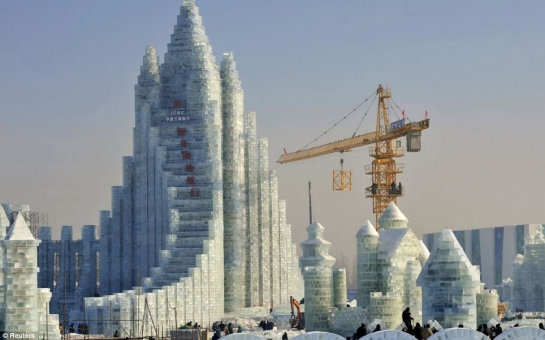Follow us !
China's giant frozen castle built entirely from ICE - PHOTO
World
10:40 | 28.12.2013

China's giant frozen castle built entirely from ICE - PHOTO
These pictures show an enormous frozen castle - built entirely from ice - created for the 30th Harbin Ice and Snow Festival.The remarkable tower, which is at least 26 metres high and measures around 20 storeys, is one of the main attractions at the festival - which sees thousands of tourists flock to the city of Harbin, near the China and Russian border, every year.In this series of photographs, workers can be seen chipping blocks of ice from the nearby Songhua River for the tower, before dragging the 551lb blocks towards the site.One worker is then pictured putting the blocks in place, before pouring water on them to freeze them together.Another can then be seen polishing the work to give it an amazing, crystal-like finish.According to event organisers, 10,000 people were employed to complete hundreds of ice and snow sculptures at the event - some areas of which are already open to the public.Some of the pieces measure more than 26 metres tall and 117 metres wide. Overall, the whole site is well over 600,000 sq metres.All in all, about 180,000 sq metres of ice and 150,000 sq metres of snow will be used to complete all the works.In the evening, some of the structures are lit up in a beautiful light-show display.Some of these pictures show the spectacle - with numerous palaces, towers and monuments in the festival lit up in every colour of the rainbow.In the New Year, tourists can enjoy the artwork for themselves in addition to the Ice Lantern Garden Party, skiing, figure skating and theatre performances.Visitors may also wish to visit the event's Siberian Tiger Park or perhaps watch fishing, swimming and diving performances on the frozen river.Others may wish to enjoy a tipple in the event's ice bar.Some visitors to the area have already been enjoying horse-drawn carriage rides across the frozen river.Harbin's festival is one of world's four largest international ice festivals, along with Japan's Sapporo Snow Festival, Canada's Quebec Winter Carnival, and Norway's Ski Festival.It officially starts on January 5 and usually lasts to the end of February, weather permitting.(dailymail.co.uk)ANN.Az










